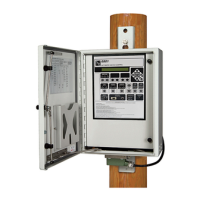Ground Overcurrent Detection Setup Procedure
To determine the proper setting, look at the source-side protective device’s ground TCC
curves for a range of fault duty, up to the maximum available ground fault current at
the sectionalizing switch. The switch control must be able to detect the fault before the
source-side protective device trips. See Figure 15 on page 33.
Ground Fault Detection Current Level (RMS Amps)
This congures the RMS level of neutral or ground current required to indicate the
presence of a possible ground overcurrent (fault) condition. (Range: 0-65.535; Step: 1;
Default: 100 when current sensor ratio is 600:5; otherwise, Default: 200)
Set the Ground Fault Detection Current Level value equal to ground minimum
pickup/trip current of the source-side protective device.
Find the switch control time-current curve for that minimum ground-trip current.
See Figure 15 on page 33.
Compare the time-current curves to the time-current curve for the protective device.
The curve for the protective device should include the mechanical operating time. The
switch control response time should be set less than 75% of the source-side protective
device’s total clearing time for fault current values up to the maximum line-to-ground
fault current at the control. To compare times, select several fault current values between
the configured Ground Fault Detection Current Level setpoint and maximum avail-
able faults at the control. For each fault-current value selected, determine the response
and clearing times from the time-current curves. In each case, the control response
time should be less than 75% of that of the source-side protective device clearing time.
If necessary, reduce the Ground Fault Detection Current Level value until the
switch control’s response time is short enough. When the Ground Fault Detection
Current Level setting is not found on an existing curve, estimate the points and plot
them on the coordination sheet with the source-side protective device TCC curve. Where
more accuracy is needed, interpolate the points between the nearest pair of curves.
For example, to interpolate a 231-amp point, the detection times are needed for the
200- and 250-amp curves at the specific fault-current level. The 231-amp point is the 200
detection time plus the difference between the 200- and 250-amp detection times
multiplied by (231-200)/(250-200).
For locations where the load current exceeds the configured Ground Fault Detection
Current Level setpoint and the circuitry is four-wire grounded wye, source-side line-to-
ground faults on a four-wire grounded wye distribution system can reduce load current
on faulted phase(s) and result in an imbalance up to the magnitude of the phase load
current. The switch control records a ground fault when the unbalanced current exceeds
the configured Ground Fault Detection Current Level setpoint for a period equal to
the configured Ground Fault Duration Time Threshold setpoint. When the event is
followed by a loss of voltage, the control will count. During stand-alone sectionalizing,
the control may go to a full count and trip. For IntelliTeam systems, registering a false
fault may prematurely shut down both the reconfiguration and the service-restoration
processes, and customers will experience an unnecessary outage. Prevent this by set-
ting the Ground Fault Detection Current Level setpoint to a value greater than the
load current. A disadvantage to this is that the switch control will ignore any low-level
ground faults below the setpoint. However, in most cases the fault-current levels will be
high enough to be detected by the high-speed phase-fault detection system. This is true
for underground lines where the faults are usually low impedance, high current, and
persistent. (Range: 0-65,535; Step: 1; Default: 100)
Ground Fault Duration Time Threshold (Milliseconds)
This setpoint congures the time a detected ground-overcurrent condition must be
continuously present before the switch control will register a ground-overcurrent fault.
Set this to a value less than the source-side protective device total clearing time minus
the Time Block inrush restraint (if any) minus the time required to detect a ground fault.
The resolution of this value is 50 milliseconds (3 cycles), so this value should be rounded
down to the nearest multiple of 50 milliseconds. Values of 0 or 50 milliseconds for this
setpoint will yield the same effective time threshold of 50 milliseconds. When using
Switch Control Setup
32 S&C Instruction Sheet 1045-530

